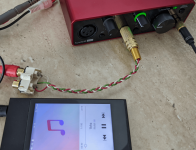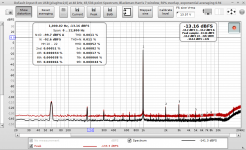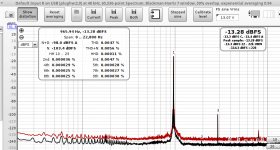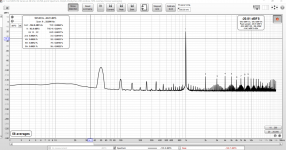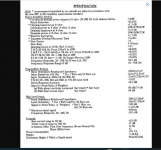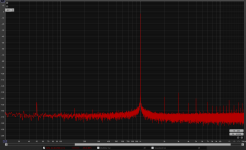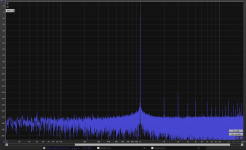wow i have been wondering to buy signal generator and osciloscope, but it think this threas just saved my wallet. i need to buy those big power resistor for testing
anyway, i have Tascam US-322 which seems have basic requirement to do this. anyone ever used this tascam? any good result?
anyway, i have Tascam US-322 which seems have basic requirement to do this. anyone ever used this tascam? any good result?
Do the loopback (Left output sine, right input) "self-test" and report the measurement result (spectrum with harmonic analysis) here.anyway, i have Tascam US-322 which seems have basic requirement to do this.
I have the US 122 and it's too dirty for the best amplifiers. For ordinary tube amplifiers and speakers, its self distortion is still waay below what you'd likely measure. I can only imagine the 322 has advanced some in this regard.
hmm bad news, i bought this tascam 2nd hand item for behringer ecm8000 then switch into umik-1. never used this tascam & ecm combo anymoreDo the loopback (Left output sine, right input) "self-test" and report the measurement result (spectrum with harmonic analysis) here.
I have the US 122 and it's too dirty for the best amplifiers. For ordinary tube amplifiers and speakers, its self distortion is still waay below what you'd likely measure. I can only imagine the 322 has advanced some in this regard.
anyway i will try it later, just ordered 100W dummy load resistor 4 & 8 ohm and find out how this test work.
Working with REW using the following:-
- Focusrite Scarlett Solo
- FiiO M7 Audio Media Player
- Mini-itx computer with Linux
- 1khz file copied from Audacity to the M7. The FiiO fixed line output is 2v p-p
Attachments
Q1: What can be done about the strong 3rd harmonic from a Wien/Lamp 1khz oscillator. I was thinking about using 1/2 LM4562 as some kind of filter.Working with REW using the following:-
- Focusrite Scarlett Solo
- FiiO M7 Audio Media Player
- Mini-itx computer with Linux
Q2: What connections are needed to loopback the SOLO for calibration.
Attachments
I'm trying to look at saved measurements on noise density scale (V/sqrtHz) but I don't see it in the dropdown menu. I can measure on that scale in RTA window but when looking at the saved measurements I don't have the noise density scale (Overlays window as well).
That sounds great!
I was thinking, any way of doing math on measurements? I'd like to subtract my LNA+ADC's noise from the measurement so I can save one that's just the noise of the DUT.
Any chance of something like this sometime in the future?
I was thinking, any way of doing math on measurements? I'd like to subtract my LNA+ADC's noise from the measurement so I can save one that's just the noise of the DUT.
Any chance of something like this sometime in the future?
The Akitika seems to be the best but I am working on an interesting DIY 1Khz. That is why I ask questions here.Have you tried the REW generator? It's very good. I have an Akitika 1KHz generator but hardly ever use it. I have the Scarlett Solo too. Just be sure to calibrate the REW generator before using. I use a 60 Hz sine wave for calibration since that's the most accurate frequency for my DMM.
I am currently measuring both a Victor and an Akitika 1 kHz oscillator using REW and a COSMOS APU 1kHz notch with the a calibration file applied in REW under microphone calibrations. I am reading -110dB for a 2nd harmonic with +6dB switch engaged and -104dB with 0dB switch engaged. BTW, I'm using a Focusrite Solo for my ADC. I thought with the compensation file, that REW would read direct. However if I subtract the 30dB of the notch from the reading, I get something closer to what it should be reading. Any ideas what checkbox I've left unchecked?
Last edited:
This thread is awesome for someone like myself who wants to simply get basic measurements (frequency response and THD) to ensure things check-out alright with my projects.
Hopefully RME interfaces work well enough (Babyface Pro FS) with REW?
Hopefully RME interfaces work well enough (Babyface Pro FS) with REW?
Here's a screen grab of a Nad 3020's distortion at full power before recap. Feeding a Motu M2 via Autoranger outputting 500mv and victors Oscillator. Seems pretty close to spec still. Any thoughts?
Attachments
Last edited by a moderator:
hi, need some help
what kind of windowing should be used to get closer to real THD+n distortion numbers?
depending on windowing i get ~123dB THD+N (Blackman-Harris 7; oh wow great... but probably not true 🙂 ) or ~113dB (Hann). probably the latter value is the real one (or closer to).
my setup is SMSL Su-9n + Cosmos ADC in MONO
Cosmos ADC set @4.7Vrms input; input impedance 1.7kOhm (Hot - GND); SMSL output voltage 3.15Vrms between Hot-Cold pin
what kind of windowing should be used to get closer to real THD+n distortion numbers?
depending on windowing i get ~123dB THD+N (Blackman-Harris 7; oh wow great... but probably not true 🙂 ) or ~113dB (Hann). probably the latter value is the real one (or closer to).
my setup is SMSL Su-9n + Cosmos ADC in MONO
Cosmos ADC set @4.7Vrms input; input impedance 1.7kOhm (Hot - GND); SMSL output voltage 3.15Vrms between Hot-Cold pin
Attachments
found an older thread, but ot conclusive
https://www.diyaudio.com/community/threads/fft-and-windowing.241657/
https://www.diyaudio.com/community/threads/fft-and-windowing.241657/
I always use BH7. Just take note of the settings - and a good way is to show the settings dialog box on your screenshots so we know how much averaging, etc. The SU-9n is one of the best DACs out there and should probably best your ADC. You should also use a very low distortion 1kHz oscillator like Viktor’s source. -123dB is not unreasonable from SU-9n.
I have started to show this dialog on the upper right of my FFTs.

I have started to show this dialog on the upper right of my FFTs.
- Home
- Design & Build
- Software Tools
- How to - Distortion Measurements with REW
